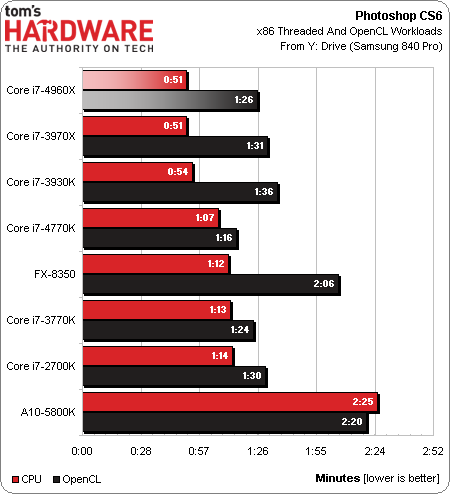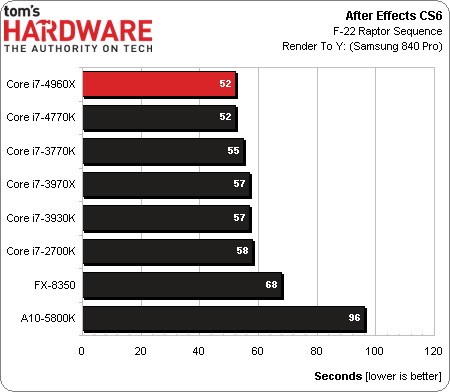Intel Core i7-4960X Review: Ivy Bridge-E, Benchmarked
Results: Adobe CS6
We use two distinct Photoshop benchmarks, one of which fully taxes each processor’s x86 cores using well-threaded filters, and another that is OpenCL-optimized to leverage graphics resources. Don’t compare the black and red bars above—they’re only together to save space (and your scrolling finger).
Core i7-4960X pretty much ties the Sandy Bridge-E-based -3970X in our CPU-based metric. You'd assume that Ivy Bridge-E would have an advantage, right? It turns out that we also discovered that Core i7-3770K wasn't any faster than -2700K in this test more than a year ago. On the other hand, all of Intel’s six-core CPUs outmaneuver the company’s quad-core offerings.
The OpenCL-accelerated metric is less consistent, seeming to favor architecture over core count or clock rate. For instance, the Haswell-based Core i7-4770K places first, followed by the Ivy Bridge-based Core i7-3770K and -4960X. Four- and six-core Sandy Bridge-based processors group up in a third clump, while AMD’s CPUs fall pretty far back.
The architectural benefit of adopting Ivy Bridge helps Intel’s Core i7-4960X claim a first-place finish, though nobody’s going to upgrade from Sandy Bridge-E for a 5% speed-up. A more demanding render project might create a larger delta between CPUs, and we’re working on sourcing a real-world project to test this theory.
After Effects is a special case where adding cores doesn’t always help performance as the available memory per core shrinks. That’s why you see the Core i7-3970X and -3930K in the middle of the chart. Between its 16 GB of DDR3-1600 and the Ivy Bridge architecture, though, Intel’s Core i7-4960X manages to tie the first-place -4770K.
Get Tom's Hardware's best news and in-depth reviews, straight to your inbox.
-
Someone Somewhere Probably would have been nice to be 8-core. Isn't the actual die on these things just a cut-down 12-core chip? Think I read that somewhere.Reply
EDIT: Minor error:
surface alongside Haswell-based 9-series chipsets
Shouldn't that be Broadwell? -
designasaurus There's a rumor going around that Ivy-E is going to have a soldered heatspreader instead of using thermal paste. Obviously this would be a big differentiator for enthusiasts picking between Haswell and Ivy-E. Given your access to Ivy-E, do you guys at Tom's have any opinions on this rumor?Reply -
killerchickens I bet it overclocks like a beast. :)Reply
Lol now time to spend $1000 to save on my power bill. -
ingtar33 about all i'd expect. shame really, but it looks like the enthusiast market is at a standstill till AMD starts to compete again.Reply -
sna too early to judge...Reply
The 6 cores ivyBridge-e "K" version is the real thing.
and I dont get it , how Tomshardwae fails to say about the SandyBridge-e not having PCIE 3.0 support , while the ivy-E has PCIe 3.0 support . this is a Big factor here. -
ingtar33 Reply11172422 said:too early to judge...
The 6 cores ivyBridge-e "K" version is the real thing.
and I dont get it , how Tomshardwae fails to say about the SandyBridge-e not having PCIE 3.0 support , while the ivy-E has PCIe 3.0 support . this is a Big factor here.
they did say it. You didn't read the beginning of the review. Of course pci-e 3.0 is a gimmick and not a reason to buy a new 2011 mb and ib-e chip... and it will remain a marketing gimmick untill gpus can actually be bottlenecked by pci-e 2.0 x16... high end gpus barely bottleneck on pci-e 2.0 x8 atm... it will be a little while (another generation or 3) before gpus will NEED pci-e 3.0.
-
Someone Somewhere Replyofficial PCI Express 3.0 compliance (remember, Sandy Bridge-E only claimed 8 GT/s signaling support), and 22 nm manufacturing.
That's pretty much saying it did it unofficially.
Besides, you have to look hard to find something bottlenecked by PCIe2.0x8; even high-end GPUs won't run into bandwidth limitations. -
CommentariesAnd More WOW !!!!!!! So Intel is expecting someone to spend another 1000 bucks just for a 10-20% boost. Yay!!!!!!!! This is Ivy Bridge-E. I am getting it , YAY!!!!!!!!!!!!!Reply -
shin0bi272 still no gaming benchmarks eh? I guess I'll save my money and stick with my i7-920 for a little bit longer.Reply



